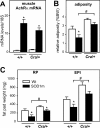A mutation in the dynein heavy chain gene compensates for energy deficit of mutant SOD1 mice and increases potentially neuroprotective IGF-1
- PMID: 21521523
- PMCID: PMC3111394
- DOI: 10.1186/1750-1326-6-26
A mutation in the dynein heavy chain gene compensates for energy deficit of mutant SOD1 mice and increases potentially neuroprotective IGF-1
Abstract
Background: Amyotrophic lateral sclerosis (ALS) is a fatal neurodegenerative disease characterized by a progressive loss of motor neurons. ALS patients, as well as animal models such as mice overexpressing mutant SOD1s, are characterized by increased energy expenditure. In mice, this hypermetabolism leads to energy deficit and precipitates motor neuron degeneration. Recent studies have shown that mutations in the gene encoding the dynein heavy chain protein are able to extend lifespan of mutant SOD1 mice. It remains unknown whether the protection offered by these dynein mutations relies on a compensation of energy metabolism defects.
Results: SOD1(G93A) mice were crossbred with mice harboring the dynein mutant Cramping allele (Cra/+ mice). Dynein mutation increased adipose stores in compound transgenic mice through increasing carbohydrate oxidation and sparing lipids. Metabolic changes that occurred in double transgenic mice were accompanied by the normalization of the expression of key mRNAs in the white adipose tissue and liver. Furthermore, Dynein Cra mutation rescued decreased post-prandial plasma triglycerides and decreased non esterified fatty acids upon fasting. In SOD1(G93A) mice, the dynein Cra mutation led to increased expression of IGF-1 in the liver, increased systemic IGF-1 and, most importantly, to increased spinal IGF-1 levels that are potentially neuroprotective.
Conclusions: These findings suggest that the protection against SOD1(G93A) offered by the Cramping mutation in the dynein gene is, at least partially, mediated by a reversal in energy deficit and increased IGF-1 availability to motor neurons.
Figures






Similar articles
-
Interaction between familial amyotrophic lateral sclerosis (ALS)-linked SOD1 mutants and the dynein complex.J Biol Chem. 2007 Jun 1;282(22):16691-9. doi: 10.1074/jbc.M609743200. Epub 2007 Apr 2. J Biol Chem. 2007. PMID: 17403682
-
A dynein mutation attenuates motor neuron degeneration in SOD1(G93A) mice.Exp Neurol. 2006 Mar;198(1):271-4. doi: 10.1016/j.expneurol.2005.12.005. Epub 2006 Jan 20. Exp Neurol. 2006. PMID: 16427626
-
A novel mouse model with impaired dynein/dynactin function develops amyotrophic lateral sclerosis (ALS)-like features in motor neurons and improves lifespan in SOD1-ALS mice.Hum Mol Genet. 2008 Sep 15;17(18):2849-62. doi: 10.1093/hmg/ddn182. Epub 2008 Jun 25. Hum Mol Genet. 2008. PMID: 18579581
-
Delayed disease onset and extended survival in the SOD1G93A rat model of amyotrophic lateral sclerosis after suppression of mutant SOD1 in the motor cortex.J Neurosci. 2014 Nov 19;34(47):15587-600. doi: 10.1523/JNEUROSCI.2037-14.2014. J Neurosci. 2014. PMID: 25411487 Free PMC article.
-
Transgenic mice with human mutant genes causing Parkinson's disease and amyotrophic lateral sclerosis provide common insight into mechanisms of motor neuron selective vulnerability to degeneration.Rev Neurosci. 2007;18(2):115-36. doi: 10.1515/revneuro.2007.18.2.115. Rev Neurosci. 2007. PMID: 17593875 Review.
Cited by
-
Cargo distributions differentiate pathological axonal transport impairments.J Theor Biol. 2012 May 7;300:277-91. doi: 10.1016/j.jtbi.2012.01.019. Epub 2012 Jan 25. J Theor Biol. 2012. PMID: 22285784 Free PMC article.
-
Astrocyte-Mediated Neuromodulatory Regulation in Preclinical ALS: A Metadata Analysis.Front Cell Neurosci. 2018 Dec 17;12:491. doi: 10.3389/fncel.2018.00491. eCollection 2018. Front Cell Neurosci. 2018. PMID: 30618638 Free PMC article.
-
Cytoplasmic dynein heavy chain: the servant of many masters.Trends Neurosci. 2013 Nov;36(11):641-51. doi: 10.1016/j.tins.2013.08.001. Epub 2013 Sep 10. Trends Neurosci. 2013. PMID: 24035135 Free PMC article. Review.
-
Dynactin Deficiency in the CNS of Humans with Sporadic ALS and Mice with Genetically Determined Motor Neuron Degeneration.Neurochem Res. 2013 Sep 28;38(12):2463-73. doi: 10.1007/s11064-013-1160-7. Online ahead of print. Neurochem Res. 2013. PMID: 24078265 Free PMC article.
-
Downregulating carnitine palmitoyl transferase 1 affects disease progression in the SOD1 G93A mouse model of ALS.Commun Biol. 2021 Apr 30;4(1):509. doi: 10.1038/s42003-021-02034-z. Commun Biol. 2021. PMID: 33931719 Free PMC article.
References
-
- Dupuis L, Pradat PF, Ludolph AC, Loeffler JP. Energy metabolism in amyotrophic lateral sclerosis. Lancet Neurol. 2010;10(1):75–82. - PubMed
-
- Dupuis L, Corcia P, Fergani A, Gonzalez De Aguilar JL, Bonnefont-Rousselot D, Bittar R, Seilhean D, Hauw JJ, Lacomblez L, Loeffler JP, Meininger V. Dyslipidemia is a protective factor in amyotrophic lateral sclerosis. Neurology. 2008;70:1004–1009. doi: 10.1212/01.wnl.0000285080.70324.27. - DOI - PubMed
-
- Dorst J, Kühnlein P, Hendrich C, Kassubek J, Sperfeld AD, Ludolph AC. Patients with elevated triglyceride and cholesterol serum levels have a prolonged survival in Amyotrophic Lateral Sclerosis. J Neurol. 2010;258(4):613–7. - PubMed
LinkOut - more resources
Full Text Sources
Miscellaneous

